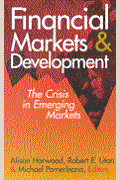Studies in this week’s Hutchins Roundup find the market value of American banks is driven in large part by the value of government guarantees, asset prices and current account deficits are better at signaling financial distress than credit growth, and more.
Want to receive the Hutchins Roundup as an email? Sign up here to get it in your inbox every Thursday.
The market value of American banks is driven in large part by the value of government guarantees
The ratio of market value to book value of equity for banks was close to 1 until the 1990s, more than doubled between 1996 and 2007, and fell back close to 1 after the 2008 financial crisis. Andrew Atkinson of University of California, Los Angeles and co-authors decompose the change in this ratio into changes associated with banks’ underlying profitability and those associated with the value of implicit government guarantees stemming from taxpayer bailouts of banks in times of distress. They find that changes in the value of government guarantees, driven mainly by changes in bank leverage, risk taking, and the growth rate of bank balance sheets, have been at least as important as banks’ true profitability in determining the value of U.S. banks over time. In particular, they find that much of the decline in the ratio of market-to-book value of equity since the financial crisis reflects regulation-mandated increases in bank capital. The authors argue that moves to lighten the regulatory burden on banks going forward should be met with caution, as even moderate increases in bank risk taking could return us to the days in which taxpayers had a large contingent liability to bail out banks in a crisis.
Asset prices and current account deficits are better at signaling financial distress than credit growth
Research, policy discussions, and monitoring frameworks since the financial crisis have focused on credit growth as a key indicator of financial risk. Using data on 17 countries from 1870 to 2012, Michael Kiley of the Federal Reserve Board finds that this focus is largely misguided. Although credit growth has some limited ability to predict a financial crisis, the effect is so small it is essentially indiscernible, he shows. On the other hand, asset prices and current account deficits do a better job of predicting a financial crisis. In particular, a crisis is more likely to occur in a country when house and equity prices grow quickly and when the country has a large current account deficit. These results suggest that asset prices and current account deficits deserve more research focus and policy analysis, Kiley says.
Job suburbanization explains the majority of the relative decline in black male employment from 1970 to 2000
Using Census and Equal Employment Opportunity Data from 1970 to 2000, Conrad Miller of the University of California, Berkeley documents that firms relocated from central cities to suburban rings at an accelerated pace following World War II. In addition, he finds that, holding constant detailed job characteristics, suburban firms have been less likely to employ black workers than similar firms in central cities. Exploiting variation in suburbanization rates across metropolitan statistical areas, he shows that a 10 percent decline in the fraction of jobs located in the central city reduces black employment rates in a metropolitan statistical area by 1.3 to 1.9 percent and increases white employment rates by 0.3 to 0.4 percent. These estimates imply that job suburbanization can explain the majority of the relative decline in black male employment from 1970 to 2000, Miller says.
Chart of the week: Self-employment has declined despite the rise of the gig economy
 Quote of the week:
Quote of the week:
“Bringing us to the present day, we are in a much, much better place, in terms of both the financial sector and the overall economy. …As a policymaker, solid growth, a strong labor market, and inflation near our target are all exactly what I want to see. Paradoxically, it’s precisely this sense that things have gotten so much better that worries me most. Although we have seen marked improvements in the critical areas of capital, liquidity, and resolution, we have not yet fully addressed the root causes of many of the problems that have plagued the financial sector. I am thinking of not only the excessive risk-taking and leverage in the run-up to the crisis, but also … an inadequate corporate culture, where accountability and ethical conduct have fallen by the wayside,” says John Williams, president of the Federal Reserve Bank of New York.
“The good times we’re in can exacerbate these problems in three ways. First, there’s a risk of complacency setting in—an ‘if it ain’t broke, don’t fix it’ mentality. Second, in a strong economy, the hard numbers that we tend to focus on when examining profits, losses, capital, and liquidity can look like everything’s coming up roses, even when an uncomfortable reality lies beneath. And, finally, culture is a long-run investment that takes many years to develop and requires constant reinforcement to preserve. If you let it erode, you can’t go to the market and obtain a new ‘culture’ overnight. … [E]stablishing a more robust regulatory framework was absolutely necessary for a healthier, more resilient financial system. But, it is far from sufficient. The danger we face today is that people may conclude that the hardened defenses are enough, and other supervisory activities around culture, conduct, and governance are superfluous.”
The Brookings Institution is committed to quality, independence, and impact.
We are supported by a diverse array of funders. In line with our values and policies, each Brookings publication represents the sole views of its author(s).








Commentary
Hutchins Roundup: Value of American banks, signals of financial distress, and more
June 21, 2018